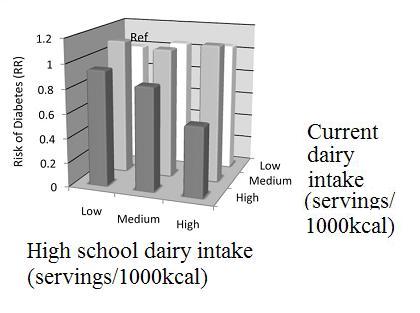Type 2 diabetes is increasingly common in Western nations and is associated with obesity, metabolic syndrome and cardiovascular disease. These conditions are thought to be caused by chronic inflammation and oxidative stress, that results from poor quality diet combined with micronutrient deficiencies. Many studies have suggested that dairy products reduce the risk of developing metabolic syndrome or type 2 diabetes. The reason for the protective effects are not know, but may relate to the increased calcium intakes seen in those who consume dairy products, specifically milk. For example, calcium has been shown to be protective of obesity, which is a risk factor for type 2 diabetes. Alternatively, high dairy intake may be associated with a better overall diet quality. Because type 2 diabetes takes decades to manifest, researchers are interested in investigating associations between diet in early adulthood and the risk of diabetes.
Researchers1 have examined the incidence of type 2 diabetes in relation to adolescent dairy product consumption in women, using data collected from the Nurses’ Health II Cohort Study. In total, 37,038 female subjects completed a food frequency questionnaire for their high school age diet and their incidence of diabetes was noted in follow up. Those women in the highest quintile for adolescent dairy product intake had a 38% lower risk of developing type 2 diabetes compared to those in the lowest quintile. Adjustment for both adolescent and adult risk factors failed to remove the significance of the result, except when adult dairy consumption and weight change since age 18 were adjusted for. A consistent intake of dairy through adolescence and into adulthood, protected against type 2 diabetes and those with the highest intakes had the lowest risk of diabetes.
Figure 1. Relative risk of diabetes in relation to current and high school intakes of dairy products. The low high school, low adult intake was used as the reference. Data adjusted for age, current BMI, total energy intake, family history of diabetes, smoking status, physical activity, alcohol use, oral contraceptive use, hormone replacement therapy, polyunsaturated to saturated fat ratio, glycaemic load, and intakes of cereal fibre, trans fat, processed meat, carbonated soft drinks, fruit drinks, and coffee.
Those subjects with high dairy product consumption were more likely to have a lower glycaemic load, a lower polyunsaturated fatty acid to saturated fatty acid ratio, have higher intakes of vitamin D and lower intakes of sugar sweetened drinks, coffee, cereal fibre, processed meat, red meat and trans fats. Higher adolescent dairy intakes also correlated with higher adult dairy intakes. This suggest that those with higher dairy intakes have consistently higher quality diets that those with lower intakes. These results agree with previous studies that show a high quality diet to be protective of type 2 diabetes, but are the first data to show that this protection may begin in early adulthood. The calcium in dairy products may also be protective of high blood pressure and weight gain, and dairy consumption may have beneficial effects on glycaemic index of foods by increasing gut transit times.
RdB

